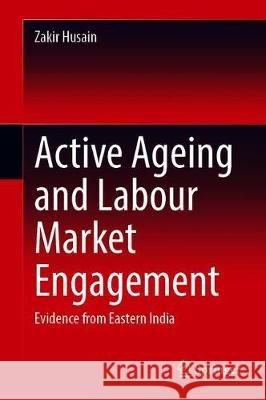Active Ageing and Labour Market Engagement: Evidence from Eastern India » książka



Active Ageing and Labour Market Engagement: Evidence from Eastern India
ISBN-13: 9789811505829 / Angielski / Twarda / 2019 / 145 str.
Active Ageing and Labour Market Engagement: Evidence from Eastern India
ISBN-13: 9789811505829 / Angielski / Twarda / 2019 / 145 str.
(netto: 192,11 VAT: 5%)
Najniższa cena z 30 dni: 192,74
ok. 22 dni roboczych
Bez gwarancji dostawy przed świętami
Darmowa dostawa!
1
AGEING AND ITS IMPLICATIONS
1.1
Definition of ageing
1.2
Global trends in ageing
1.3
Ageing in India
1.3.1
Health challenge: Rising burden of NCDs
1.3.2
Economic challenge: Lack of economic security
1.3.3
Social challenge: Feminization of aged
1.3.4
Government response: Successes and failures
1.4
Regional variations
1.5
Role of aged in Indian society
1.6
Research problem
1.6.1
Conceptual framework
1.6.2
Research questions
1.6.3
Data base and methodology
1.7
Implications
1.8
Structure of study
References
2
AGED AS AN ASSET IN INDIA: A REVIEW OF LITERATURE
2.1
Introduction
2.2
Active ageing
2.3
Work participation of elderly: A brief literature review
2.3.1
Workforce participation among aged in India
2.3.2
Work and earnings
2.4
Aged in the labour market
2.4.1
Work force participation
2.4.2
Informal sector and the aged
2.4.3
Occupational pattern of aged workers
2.4.4
Earnings
2.4.5
Non financial contribution of the elderly
2.5
Conclusion
References
3
UNDERSTANDING THE DATA
3.1
Introduction
3.2
NSSO data
3.2.1
Construction of variables
3.2.2
Sample profile
3.3
Primary survey
4
ECONOMIC CONTRIBUTION OF AGED: A NATIONAL PROFILE
4.1
Introduction
4.2
Methodology
4.2.1
Functional specification
4.2.2
Results and discussion
4.3.1
Financial contribution of elderly to household expenditure
4.3.2
Changes in net financial contribution across socio-economic strata
4.3.3
Regional analysis of financial contribution of the elderly
4.3.3.a
Regional analysis of financial contribution in the 55th round of NSS
4.3.3.b
Regional analysis of financial contribution in the 68th round of NSS
4.4
Determinants of financial contribution of elderly
4.4.1
Results and discussion
4.5
Contribution of aged and its impact on household poverty
4.5.1
The all-India picture
4.6
State-wise analysis of contribution of aged and its impact on household poverty
4.6.1
Evidence from the 55th round
4.6.2
Evidence from the 68th round
4.7
Understanding impact on household poverty
4.7.1
Change of household poverty in the 55th round — Link with proportion of elderly and log of state domestic product
4.7.2
Change of household poverty in the 68th round — Link with proportion of elderly and log of state domestic product
4.8
State-wise analysis of the effects of financial contribution of elderly workers on intensity of household poverty
4.8.1
Analysis of FGT index in the 55th round
4.8.2
Analysis of FGT index in the 68th round
4.8.3
FGT Index at all India level
4.9
Summing up
References
5
ECONOMIC CONTRIBUTION OF AGED: RESULTS OF A PRIMARY SURVEY IN EASTERN INDIA
5.1
Introduction
5.2
Work force participation
5.3
Nature of employment
5.4
Earnings and gross contribution to household
5.5
Determinants of working, earnings and gross contribution
5.6
Indirect economic contribution of aged
5.6.1
Aged and household chores
5.6.2
Imputing economic value to household chores
5.6.3
Net contribution of aged
5.6.4
Econometric analysis
5.7
Summing Up
References
6
DAILY LIFE OF AGED: AN ANALYSIS OF TIME USE DIARIES
6.1
What are Time Use studies?
6.2
Studies on Time use
6.3
Objective and methodology
6.4
Results from Eastern India
6.4.1
Mean time spent on activities
6.4.2
Percentage time allocated on broad activity groups
6.4.3
Variations in percentage time allocated on broad activity groups across correlates
6.5
Econometric analysis
6.5.1
Active ageing as dependent variable: Least square model
6.5.2
An alternative econometric model
6.6
Conclusion
References
7
CONCLUSION
7.1
Returning to research questions
7.2.1
Major findings
7.2.1
Economic contribution of the elderly
7.2.2
Economic contribution of the elderly: A regional profile
7.2.3
Indirect contribution of the elderly: A regional profile
7.2.4
Gross economic contribution of the elderly
7.2.5
Net economic contribution of the elderly
7.2.6
Time use pattern of aged
7.2.7
Active ageing in India
7.3
Asset, or burden?
7.4
Some policy issues
7.4.1
Promoting work force participation of aged
7.4.2
Other means of promoting active ageing
7.4.3
Healthy ageing
References
Zakir Husain is Professor at the Economics Department in Presidency University, Kolkata. He uses econometric tools and methods to study issues related to exclusion and discrimination in gerontology, education, demography, and health. Prof. Husain has been a faculty in institutes like Indian Institute of Economic Growth, New Delhi and Indian Institute of Technology, Kharagpur. He has been also been a Consultant in the Prime Minister’s High Level Committee for Preparing a Report on Status of Muslim Community in India, and a member of the West Bengal State Planning Board.
The book provides an interesting analysis of the time-use data to examine the extent to which active ageing is occurring in India. It also synthesizes data from the National Sample Survey Office All India Survey and another survey undertaken in Kolkata, Bhubaneswar, and Ranchi (capital cities of East Indian states) to examine the role of the aged in the Indian Society. Nearly all countries in the world are experiencing an important issue of ageing. India faces its own set of challenges with its aging population due to the absence of a social security system—the shifting family dynamics questions the contribution of the elderly to the family in every aspect. Econometric models have been used in the book to study gender differences and variations across socio-economic conditions, correlating them to the contribution of the aged to their families and the extent of active ageing. The book broadens the understanding on the aged and facilitates their integration in the society so that they can age more actively.
Active Ageing and Labour Market Engagement offers an analytical perspective to professionals, researchers, and policy makers interested in gerontology.
1997-2025 DolnySlask.com Agencja Internetowa
KrainaKsiazek.PL - Księgarnia Internetowa









